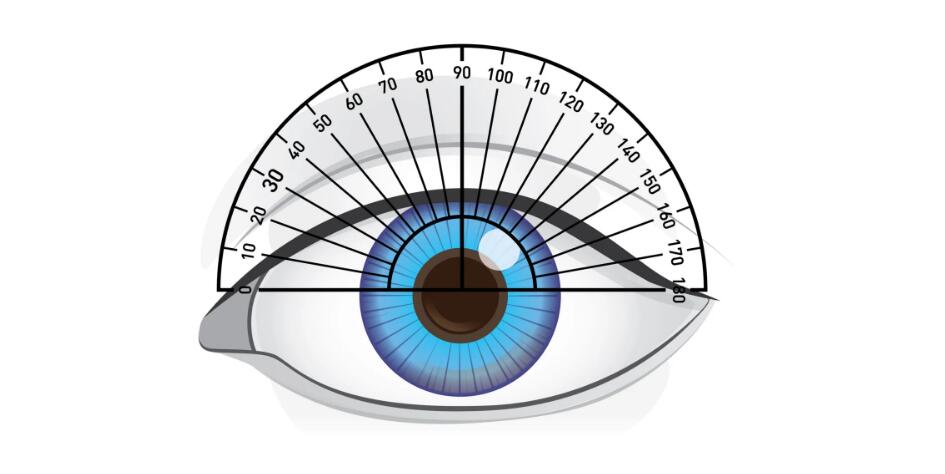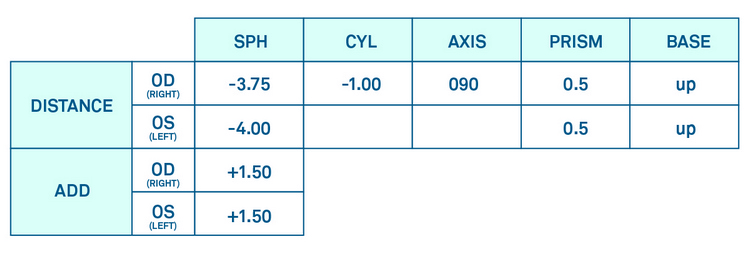- GlassesShop By FrameShop By StyleFeatured












With all the digits and abbreviations, it might be challenging to understand your eye prescription. However, understanding what they imply is crucial to the proper operation of your glasses. To assist you in better comprehending these phrases, let's take a closer look at them.

For your eye prescription to correct your vision, the Sphere, or SPH, value is crucial. It indicates and further specifies the minimum strength of lenses required to correct nearsightedness or farsightedness.
Values for SPH, or Sphere, on your prescription, are crucial indicators of your visual requirements, regardless of whether you have difficulties seeing objects near up or far out. What you should know is as follows:
·Measurement and Meridians: Consider meridians as hypothetical lines that pass across the middle of your eyes, comparable to the lines on a map. A protractor is a specialized instrument that is used to measure these lines. It is positioned over the surface of your eye.
· Nearsightedness vs. Farsightedness: You are nearsighted if your SPH value is negative, which indicates that you have problems seeing objects far away but can see things up close.
· Severity Levels:
· Mild: +/- 0.25 to +/- 2.00
· Moderate: +/- 2.25 to +/- 5.00
· Severe: Greater than +/- 5.00

The CYL number in your eyeglass prescription is crucial if you have astigmatism. When your eye is not shaped properly, it causes astigmatism and this further causes objects to appear blurry or unsteady at various distances. The CYL number so helps to correct it and restore clarity. It's like wearing magic-making glasses that focus and sharpen everything. Achieving a comfortable and clear view of the world requires knowing your CYL number. The CYL value indicates the additional lens power required to correct this issue and ensure that the retinal tissues focus correctly. Not every prescription has a CYL number since not everyone has one. But in order to see clearly, it's critical to comprehend the CYL number. They c
an determine the best technique to restore your vision's sharpness and clarity by reviewing the CYL number on your prescription and with the proper eyeglass prescription adjusted to your needs, it lets you view the world with no hesitation.
·Correction for Astigmatism: Astigmatism is caused by a slightly asymmetrical cornea or lens of the eye.
· Axis: The Solution to Astigmatism The astigmatism correction angle required for the cylinder to sit is indicated by the axis number. It has a range of 0 to 180 degrees and is crucial for ensuring that the correction is precisely made.
When astigmatism causes blurriness, the CYL and AXIS values come in extremely helpful. The AXIS value indicates the correction's corresponding angle, ranging from 0 to 180 degrees. Achieving the ideal setting for this can significantly improve clarity and remove any blurriness. Thus, achieving accuracy improves our vision and increases our sense of comfort.
It's essential to know your eye prescription in order to select the appropriate glasses or contact lenses. Together, the SPH, CYL, and AXIS values provide you with an exact prescription that fits your eyes. They ensure that your vision is corrected precisely as needed. The individuals' satisfaction with their contacts or glasses and their ability to see clearly were significantly improved by customized prescriptions. This demonstrates the significance of having a prescription that is customized for you.
Our eyes gradually change with age, particularly in terms of close-up vision. As we age, presbyopia is a frequent eye condition for which the ADD value becomes significant. This constant value corrects farsightedness associated with ageing. It often remains constant for both eyes and ranges from +0.75 to +3.00. The amount of additional magnification required for close-up tasks like reading is indicated by the ADD number. This ensures that, regardless of distance, we can see things comfortably and clearly.

Making sure the lenses are in the correct position is critical for seeing well and feeling comfortable in your glasses and it is considered an important and substantial factor when choosing and fitting glasses. It's important to have this measurement accurate so that your lenses sit precisely in the middle of your frames. You may experience blurry vision and increased eye fatigue if your PD measurement is incorrect.
• Make sure you are communicating clearly and accurately about the specifics of your prescription.
• Verify the accuracy of prescription values, such as SPH, CYL, AXIS, ADD, and PD, by checking them twice.
• To guarantee correct lens alignment when placing an online order for glasses, provide an exact PD measurement.
• Make sure to address any doubts you may have regarding your prescription while speaking with an optometrist
• If you are unsure about your medication or have any concerns, think about getting a second opinion.
• Make sure you have easy access to your prescription information for revisions and future use.Arrange thorough eye tests on a regular basis to track any changes in your eyesight and adjust your prescription as necessary.
Maintaining the health of your eyes requires that you understand the terminologies used in eye prescriptions. Understanding concepts like SPH, CYL, and AXIS gives you the ability to decide on your visual correction requirements with confidence. Knowing these words can help you choose the best solution for your eyes, whether it's contacts or glasses. Furthermore, speaking with eye doctors more effectively is made possible by being familiar with the terms used in eye prescriptions. Your demands for eye care can be appropriately met if you speak openly about the specifics of your prescription.Making wise decisions is the first step towards feeling comfortable about your vision. Educate yourself on the terminology used in eye prescriptions and take charge of your visual health right now.

